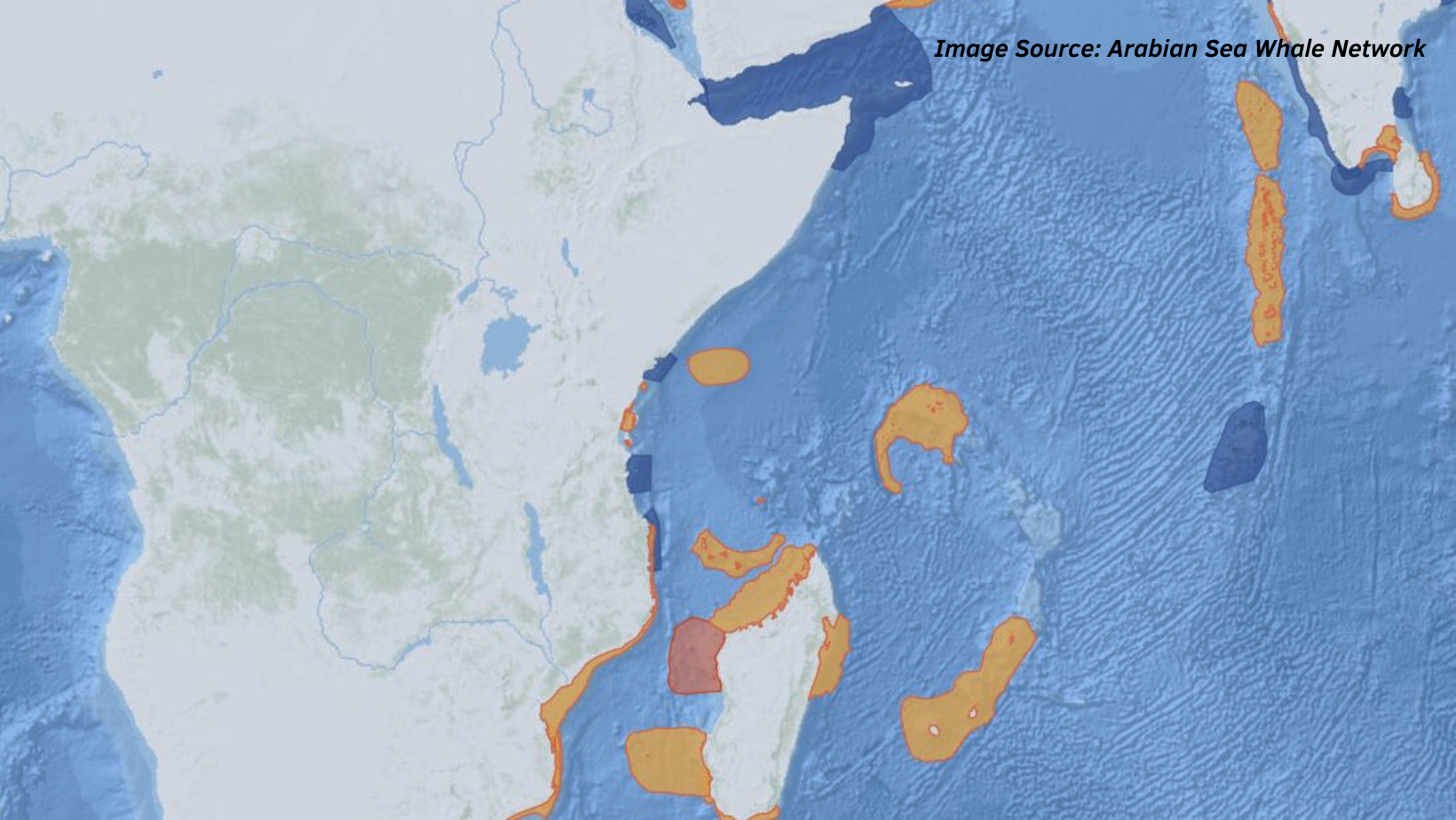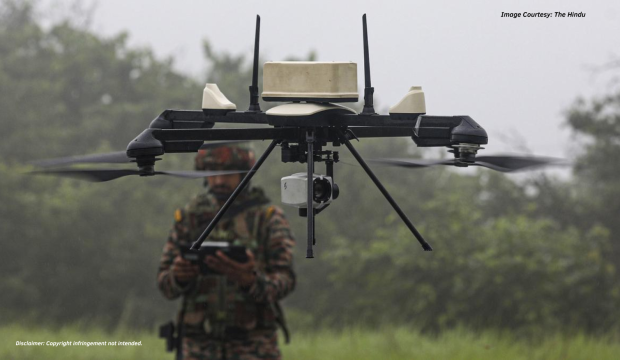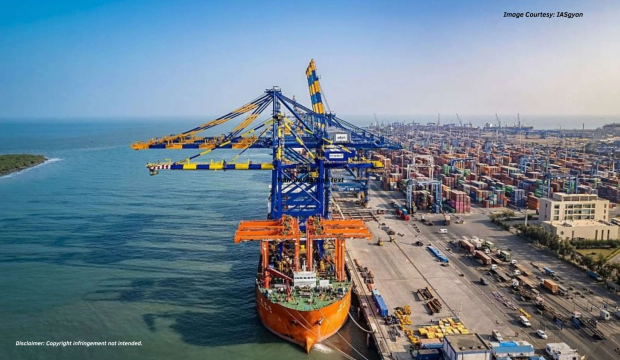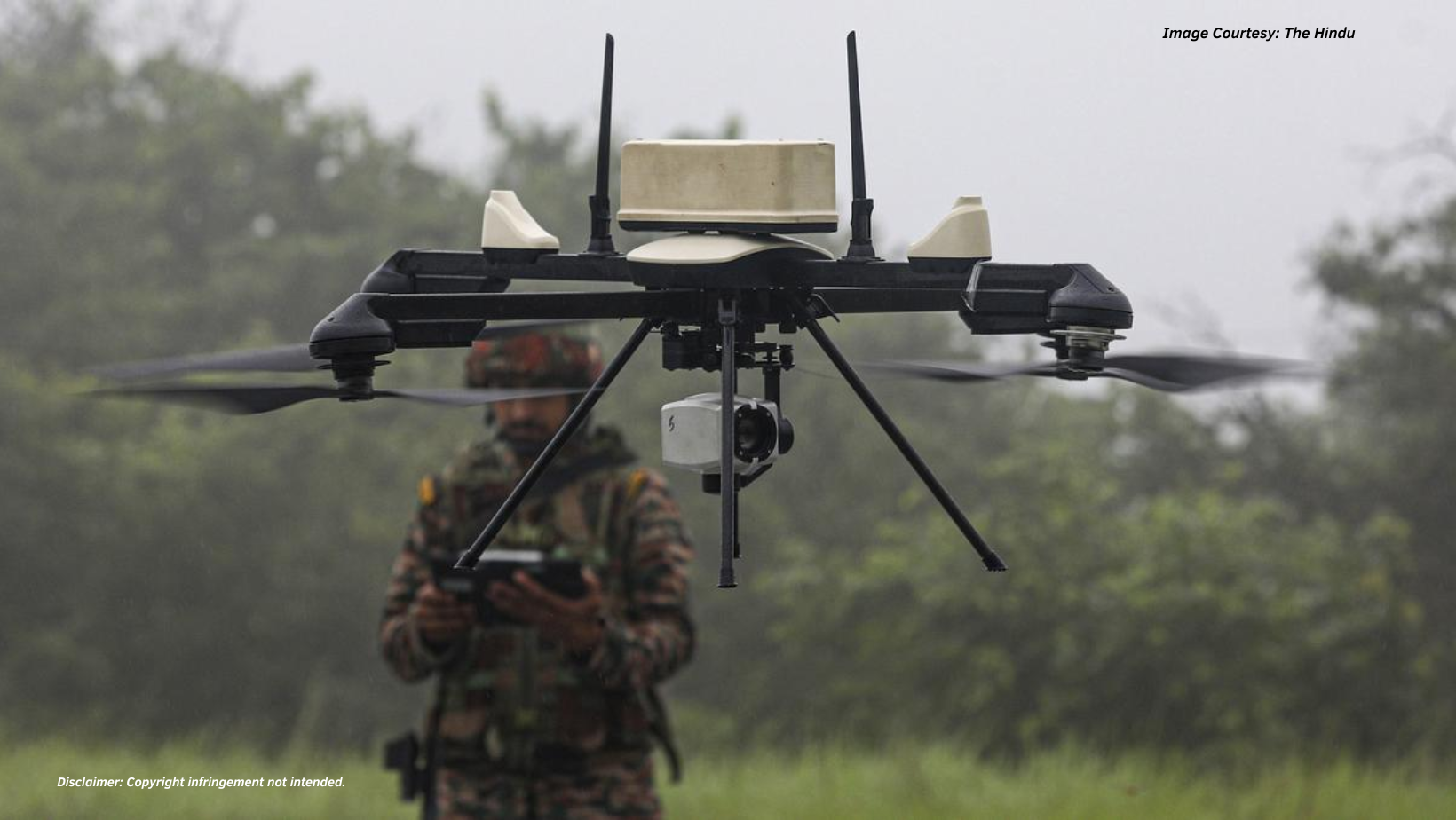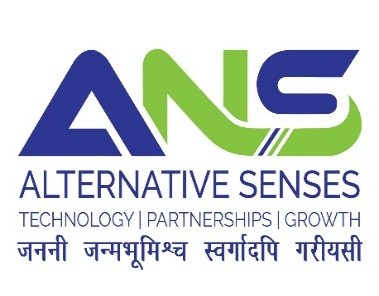Introduction
The Indian Ocean has emerged as a critical juncture for trade, commerce, and transit routes for energy from West Asia. The Indian Ocean Region (IOR), which is located at the crossroads of Africa, Asia, and Australia, is home to several littoral nations and middle-power countries including countries in Africa, some small island countries like Mauritius and Seychelles and India. The geostrategic importance of the region is that having critical choke points like the Strait of Malacca, Bab-el Mandeb, Strait of Hormuz, and so on, the region is highly vulnerable to maritime piracy, changing power dynamics, international conflicts, and so on, urging the immediate attention of securing the region. Being a natural power in IOR, India’s role in securing the region with its naval presence is crucial for its national interest. Currently, India’s main objective in the IOR is to ‘secure’ the Sea Line of Communications (SLOCs), which are laden with piracy threats in the Horn of Africa and the Red Sea[1]. In March 2024, India’s intervention in the piracy incident in the IOR, and the rescuing of 23 Pakistani nationals is an interesting development, against the backdrop of the downfall in India-Pakistan ties in recent times[2]. Earlier this year, the Indian Nav y, in coordination with Seychelles and Sri Lanka, rescued a hijacked Sri Lankan fishing vessel[3]. Since December 2023, there have been more than 15 such incidents in the IOR, where the Indian Navy played a crucial role as a ‘first responder’ and ‘preferred partner’ to deal with the security environment of the region[4].
Lieutenant Colonel Dhiraj Kumar opined that the positive gesture has already reaffirmed India’s suitability as the ‘preferred security partner’ in the region, upgrading India’s stature as a crisis-mitigator and promoting cooperation among the neighbouring countries[i]. In the transition from an ‘inward-looking’ approach to an ‘outward-looking’ strategy, India’s current vision in the IOR is three folded: strengthening the commitment to support the neighbouring countries, providing full assistance in terms of humanitarian aid and capacity-building in the maritime front to the littoral countries, and preventing any hegemonic dominance in the region, especially in the context of China’s growing presence in the backyard of the region[5]. In recent years, India’s evolving approach to perceiving the ‘primary interest’ area in IOR has changed India’s outlook towards the region[6]. The extension of India’s primary interest region in 2015 Indian Naval strategic document has provided to set the stage for India’s changing maritime outlook for a broader region.
In 2015, the Indian Navy redefined its ‘sphere of interest’ from the Mozambique Channel to the Ombai-Wetar Straits in the South-eastern IOR, superseding the earlier maritime policy of India[8], contrary to the Indian Navy’s 2007 document, titled “Freedom to Use the Seas: India’s Maritime Military Strategy”, which defined only from the Persian Gulf to the Strait of Malacca, as its ‘primary area of interest’[9]. In this article, the focus will be on the western Indian Ocean region (WIOR), due to the region’s peculiar geographical positioning and a crucial link for India’s energy security. The WIOR encompasses the coastal nations including the countries like Somalia, Kenya, Tanzania, Mozambique, South Africa, Madagascar, Comoros, Mauritius and Seychelles. In third article, the researcher will investigate that how India’s naval strategy and military presence in the Western Indian Ocean Region influenced regional security dynamics and taking up the case studies of two coastal nation Seychelles and Mauritius, important for their strategic locations, how effective India’s diplomatic efforts to foster the partnerships with these countries.
India's Naval Strategy and Regional Security
Applying Sun Tzu’s dictum of “knowing the enemy” relevant, the section will discuss India’s naval presence vis-a-vis China in the region[10]. The Chinese presence in the WIOR has been considerably increased in recent years. Beijing is proportionately dependent on this region for its energy resources and international trade[11]. On the one hand, China’s expanding naval presence in the region is an alarming signal, on the other, its collusiveness with Pakistan in extending the friendship in the maritime domain is also a cause for New Delhi’s concern[12]. In the context of China’s maritime deployability, China has a sustained presence with nearly 6 to 8 warships[13].
Apart from that, research and fishing vessels such as Xiang Yang Hong 01 and Xiang Yang Hong 03 can also create an alarming situation in the region[14]. While research activities in international waters are not prohibited under UNCLOS, the ethical use of the data can be questioned[15]. As reported in The Hindu, the general area of deployment of China’s research vessel is around 90 degrees east ridge and southwest Indian ridge[16]. Last year, China delivered two Type 054A/P multi-role frigates to Pakistan[17]. The People’s Liberation Army Navy (PLAN) has already one of the largest naval presences in the IOR, with totally possessing 50 diesel-electric and 10 nuclear submarines[18]. As stated by officially, the 75th anniversary of the PLAN is undergoing huge transformation, to make a strategic force with incorporating the ‘new era’ arms with nuclear and conventional weapons[19]. China’s Navy aims for the far east and far west areas through its ‘String of Pearls’ Strategy. China also promised to deliver eight Yuan-class diesel-electric submarines with air-independent propulsion, by 2028, for enduring greater underwater navigation[20].
The scenario of Indian has been largely in the transitioning phase, but with the substantiate contributions in the region. India has been actively involved in anti-piracy operations, particularly in the Gulf of Aden. India’s naval ships regularly escort the merchant vessels and conduct patrols, contributing to the overall security of the major SLoCs. India’s involvement in the region has helped to secure the crucial maritime trade routes, enhancing regional stability. By ensuring the security of the vital maritime routes, India supports the uninterrupted flow of trade and energy resources, contributing to the economic stability of the region. Indian Navy has 132 warships with 140 aircraft and 130 helicopters vis-a-vis China’s 300 warships and submarines[21]. Considering the constraint in budgetary allocations and older warships slated to retire, the Indian Navy presently has 35 warships and 11 submarines positioning in the critical areas of the IOR[22]. While the Indian Navy’s anti-piracy efforts since 2020 have enormously enhanced its stature as the ‘preferred security partner’ in the region, China’s sustained presence is also an undeniable fact as a strategic competitor.
As reported by the Regional Cooperation Agreement on Combating Piracy and Armed Robbery (ReCAAP), there were more than 95 incidents of piracy in Asia, only in 2020[23]. In 2023, India’s operations through deploying INS Chennai against the backdrop of the ship, MV Lila Norfork, off the Somalian Coast, enhanced India’s credibility as a ‘preferred security partner’ in the maritime domain[24]. The Indian Navy’s ‘Mission-based deployment approach’ has enhanced the naval presence across the region. In this way, New Delhi enables quick responses to emerging traditional and non-traditional challenges. The widening of India’s primary interest area and its persistent footprint across the region, including the chokepoints in the Indian Ocean, New Delhi has been playing a pivotal role in securing the region.
Interestingly, the requirements from the evolving security challenges facing the WIOR remain unabated, India’s maritime outlook has considerably changed from a ‘territorial’ to a ‘non-territorial’ conception of the sea, which reaffirms India’s increasing footprint in the open seas. In January 2023, the Indian Navy commissioned a new Kaveri-class Scorpion[25] submarine, INS Vagir, indigenously built in Mumbai[26]. This is the fifth of the submarines in the Kaveri class that have been inducted into the Indian Navy. Commissioning these state-of-the-art submarines is crucial to augment the Indian Navy’s presence in the WIOR, in particular, and it will help to modernise Indian naval equipment. It will also secure India’s maritime interests in the region[27].
Strategic partnerships- Case Studies of Mauritius and Seychelles
Indian Navy has four major roles- military, diplomatic, constabulary, and benign. Indian Navy’s role beyond its deployment also reached to provide humanitarian aid and quick responses in any type of crisis in the region. The title of ‘first responder’ has been pondered by the Indian Navy to actively oversee the ‘Maritime Area of Interest’ (MAI) in the WIOR. While on one side, the concept of mission-based deployment has organised the deployment of the Indian Navy in the region, on the other, India’s growing stature has been helping to facilitate the partnership with the countries of the global south especially the littoral nations to enhance its naval capability in terms of presence and surveillance missions (PSM)[28]. By capitalising on the long history of bilateral trust, India has successfully built strategic relationships with countries like Mauritius and Seychelles.
With a strong presence of the Indian diaspora, Mauritius has always preferred India as a ‘key security partner’ in its periphery[29]. By helping to develop the Exclusive Economic Zone (EEZ) and providing financial support through the Lines of Credits (LoC), Indian has solidified its maritime security cooperation with Mauritius. The LoC, India has given Mauritius has largely been used to purchase equipment such as offshore patrol vehicles, water jet fast attack craft and the others required for the maritime security. India’s efforts to take the Agalega islands, a strategically important, in a long-term lease, illustrates India’s commitment to bolster the surveillance capabilities in the WIOR[30]. Over the years, India has become a key security partner of Mauritius. The finalisation of the Agalega islands, for an Indian outpost in the periphery of WIOR, has significantly improved India’s capability to brew the surveillance system to deal with the non-traditional maritime security threats[31].
China has been countering India’s influence in Mauritius by enhancing its economic and strategic footprint. In contrast to India’s focus on the security cooperation, China is focusing on the infrastructural projects, and huge economic investments. This is a subset of China’s large vision of extending influence over the IOR. In 2022, nearly 105 million USD of FDIs came from China to Mauritius, and this expected to increase by 8% in 2023[32]. Recently, China and Mauritius also signed the Free Trade Agreement (FTA), which is expected to have a huge surge in exports from both the side[33]. India’s proactive engagement vis-à-vis China’s strong foothold in Mauritius caters the bilateral relations between India and Mauritius. In 2015, when the Indian Prime Minister Narendra Modi visited the islands, the Memorandum of Understanding (MoU) signed to enhance the cooperation regarding the ocean economy and air transport facilities in Agalega[34]. In 2017, Mauritian Prime Minister Pravin Kumar Jugnauth during his visit to India, signed 4 agreements, including one on maritime security[35]. This further boosts India’s maritime engagement in the region. These efforts coupled with the ongoing diplomatic exchanges has positioned India to strengthened the maritime cooperation with Mauritius.
India has strategically leveraged its historical ties with Seychelles to enhance its influence in WIOR. With the help of Indian Navy, Seychelles could thwart the attempted coup against President Rene in 1986, which demonstrates India’s commitment to ensure the stability in the country. The subsequent bilateral cooperation agreement in 2003, the Indian Navy has been empowered to policing the EEZ of Seychelles[36]. This has strengthened India’s Naval presence in the region. In 2015, the visit of the Indian PM to the nation, the first in 34 years, signifies the strategic importance, and signed four agreements including one on developing facilities on Assumption Island, granting India a crucial foothold in a region of strategical importance[37]. In 2016, the Indian Coast Guard’s first Interceptor Boat C-405 was gifted to Seychelles to deepen the defence cooperation[38]. Interestingly, India’s attempt to ramp up the cooperation in IOR countries, Seychelles has been received the Dornier aircraft, handed over by India, contributing the closer defence partnerships between the two countries[39]. In response to India’s initiatives in Seychelles, China has made strategic steps like in form of infrastructural development projects and strategic engagements to expand its footprint.
The case studies of Mauritius and Seychelles underscore India’s strategic partnerships with the small island countries in the WIOR. Indian Navy plays a multifaceted role in the region, which enables India’s place as an important player for these countries. While, some scholars anxious about the increasing investment of China on the islands and capitulation of the extended financial aid might hinder the close ties with India, but India’s proactive approach is evidenced by the continuous engagement in these small island nations have placed India into a comparatively advantageous position. Through these strategic partnerships and close ties, the strong presence of Indian Navy can be a decisive factor to counter China’s ‘String of Pearls’ strategy. The close partnerships do not only serve India’s strategic interest but also the contribute to the regional stability and security in the Western Indian Ocean.
Challenges of India’s Maritime Presence in Western Indian Ocean Region
Resource constraints
India has a significant budget constraint to invest in maintaining naval presence in the vast region. Indian Navy’s share in the budget significantly declines from 18% in 2012 to 13% in 2019-20[40]. There is an acute mismatch between the ambitions to control the sea and the current capabilities of Indian Navy. India’s underutilization of tri-services in the crucial islands like Lakshadweep, Andaman and Nicobar Islands, which overlooks the important straits in the region.
Logistical challenges
Continuing the operations in a vast WIOR poses logistical challenges including the need for replenishment, maintenance and infrastructure, that will support the logistical requirements of the Indian Navy. Moreover, the changing regional dynamics, due to the difference in the strategic priorities, has made difficult to establish bases to ensure the seamless supply chains across the region. The slow progress in building Chabahar port, as a strategic priority of India, limits Indian naval presence in the WIOR.
Slow pace of modernization
Keeping pace with technological advancements, Indian Navy requires complete modernization, which is crucial for maritime security. Currently, India’s focus on the state-of-the-art technology for maritime surveillance and domain awareness, that includes the UAVs and aircraft for patrolling[41]. The network of coastal radar stations helps to monitor the entire region. However, these needs periodic maintenance and time-to-time upgradation to strengthen India’s ability secure its maritime interest.
Environmental and climate challenges
Climate change and environmental degradation have been becoming a prevalent issue in maritime operations. Rising sea levels, frequent storms and other challenges related to climate change impacts the naval infrastructure significantly. Environmental challenges have been seen as a major non-conventional threat in the region. With the high level of warming, it has been estimated that there are more likely to continue in rising sea levels, resulting in severe coastal erosion, including the vulnerabilities of the small island nations[42]. In 2021, the report of IPCC highlighted the potential disasters that the IOR might have to face in the coming decades[43].
Recommendations For Enhancing India's Influence and Security Posture in the WIOR
- New Delhi has significantly boosted its surveillance capabilities to monitor the maritime activities in the WIOR. However, considering Indian Ocean, particularly WIOR, as a vital region for global trade and energy security, India needs to further expand its regional reach and strengthened its presence over the coastal countries in Africa and small littoral countries in the region. India can foster partnerships as a part of collective interest in the WIOR and should develop the comprehensive and inclusive approach to maritime security. This will benefit both India and its regional partners and will contribute to global maritime security as a whole.
- The establishment of a robust information-sharing network across the region is the need of the hour. In 2023, New Delhi has conducted the “Maritime Information Sharing Workshop”, was hosted by the Information Fusion Centre- Indian Ocean Region (IFC-IOR), marked a new milestone in highlighting the importance of timely-information for quick response[44]. The IFC-IOR, launched in 2018, stands as a testament to India’s commitment to ensure the maritime safety and security with a collective approach. While New Delhi has a strategic upper hand for its long historical relationships with the littoral nations, to deal with the non-traditional threats such as maritime piracy, IUU fishing, and others, the tracking of maritime traffic is critical. Based on the collected information of IFC-IOR, New Delhi needs to create the wide database for anticipating the potential threats.
- New Delhi should actively invest in initiatives related to developing the blue economy including fisheries, marine resources, and tourism. China has already invested heavily in the EEZ of the littoral countries like Mauritius[45]. China is also planning to build a logistics and services hub in the region, which is understandably to protect China’s strategic interests[46]. The growing convergence of Beijing with these small littoral countries can be a threatening factor to dilute New Delhi’s traditional influence in the WIOR. Hence, India needs to adopt a proactive approach to deepen its strategic partnerships with the nations in the region.
- While there are regional forums such as the Indian Ocean Rim Association (IORA) and the Indian Ocean Naval Symposium (IONS), New Delhi’s engagement should be increased by forging security and economic agreements with the member countries. India also can increase it number of offered training and capacity-building programs for the maritime forces of the littoral nations of the region, which, in turn, will provide an edge to New Delhi’s position in the region.
Conclusion
India’s naval presence and capability in the WIOR is quite appreciable. For the last few years, New Delhi has been involved in countering several non-traditional security threats in the region. In Arthashastra, Kautilya has talked about three kinds of warfare, where he emphasised on ‘Concealed warfare’ and ‘Silent warfare’, rather than going for ‘Open warfare’, to avoid devastation. If this thought can be put in the current estrangement with China, it would be pertinent to say that India is using its military power to get soft power credentials and trustworthiness in the region. While New Delhi’s engagement and defence cooperation with the Mauritius and Seychelles are very reliable, India needs to redefine the maritime interest involving soft power engagement to develop a common ground with the partner countries bordering the western Indian Ocean.
DISCLAIMER
The paper is author’s individual scholastic articulation and does not necessarily reflect the views of CENJOWS. The author certifies that the article is original in content, unpublished and it has not been submitted for publication/ web upload elsewhere and that the facts and figures quoted are duly referenced, as needed and are believed to be correct.
References
- PTI. 2024. “Nine Pirates Being Brought to India to Face Legal Action: Indian Navy.” The Hindu, March 30, 2024, sec. India. https://www.thehindu.com/news/national/nine-pirates-being-brought-to-india-to-face-legal-action-navy-day-after-rescuing-iranian-vessel/article68009745.ece.
ANI, Twitter post, March 30, 2024, 5:46 a.m.,
(20) ANI on X: “#WATCH | The crew comprising 23 Pakistani nationals thanked the Indian Navy and raise ‘India Zindabad’ slogans after the Indian Navy’s specialist team protected them from nine armed pirates, and completed sanitisation and seaworthiness checks of FV Al-Kambar. The crew were https://t.co/0QE4B7GfSe” / X- Economic Times. 2024. “Indian Navy Collaborates with Sri Lanka and Seychelles to Rescue Hijacked Sri Lankan Fishing Vessel.” The Economic Times, January 30, 2024. https://economictimes.indiatimes.com/news/defence/indian-navy-collaborates-with-sri-lanka-and-seychelles-to-rescue-hijacked-sri-lankan-fishing-vessel/articleshow/107267582.cms?from=mdr.
- Nandy, Sumana. 2024. “Navy vs Pirates of the Arabian: Inside India’s Daring Red Sea Missions.” NDTV.com. March 31, 2024. https://www.ndtv.com/india-news/navy-vs-pirates-of-the-arabian-inside-indian-navy-daring-red-sea-missions-5343645#:~:text=The%20Navy%20responded%20to%20at%20least%2018%20incidents
- Kumar, Lieutenant Colonel Dhiraj. 2021. “Publication.” Www.usiofindia.org. 2021. https://www.usiofindia.org/publication-journal/indian-ocean-region-ior-india-as-a-net-security-provider-the-way-ahead.html.
- ORF. 2017. “Preparing for the Future Indian Ocean Security Environment.” Orfonline.org. February 23, 2017. https://www.orfonline.org/expert-speak/preparing-for-the-future-indian-ocean-security-environment-challenges-and-opportunities-for-the-indian-navy.
Nawaz, Allah. 2023. “India’s Evolving Maritime Strategy – South Asian Voices.” South Asian Voices. May 31, 2023. https://southasianvoices.org/indias-evolving-maritime-strategy/#:~:text=While%20early%20Indian%20naval%20doctrines%20show%20a%20force.
- Khurana, Gurpreet S. 2015. “Convert Word to PDF Online – Docx and Doc to PDF Supported.” Maritimeindia.org. November 20, 2015. https://maritimeindia.org/wp-content/uploads/2021/02/23-11-2015net-security-provider-defined-an-analysis-of-indias-new-maritime-strategy-2015.pdf.
- Observer Research Foundation. 2015. “India’s Evolving Maritime Strategy – Analysis.” Eurasia Review. December 7, 2015. https://www.eurasiareview.com/07122015-indias-evolving-maritime-strategy-analysis/.
Butt, Khalid Manzoor, and Sadaf Jan Siddiqui. “Growing Chinese Presence in the Indian Ocean.” Strategic Studies 41, no. 2 (2021): 64-81. Growing Chinese Presence in the Indian Ocean (jstor.org)
- Bukhari, Syed Sabreena. “Decoding China’s ambitions in the Indian Ocean: analysis and implications for India.” Australian Journal of Maritime & Ocean Affairs 14, no. 2 (2022): 136-147. Decoding China’s ambitions in the Indian Ocean: analysis and implications for India (tandfonline.com)
- Panneerselvam, Prakash . 2022. “China’s Emerging Subsurface Presence in the Indian Ocean.” Thediplomat.com. December 3, 2022. https://thediplomat.com/2022/12/chinas-emerging-subsurface-presence-in-the-indian-ocean/.
- Pandit, Rajat. 2023. “India Keeping Close Tabs on China-Pak Collusion in the IOR, Revising Plans: Navy Chief.” The Times of India. Times Of India. December 2023. https://timesofindia.indiatimes.com/india/india-keeping-close-tabs-on-china-pak-collusion-in-the-ior-revising-plans-navy-chief/articleshow/105664264.cms.
- Brar , Aadil . 2024. “China’s Ocean Spy Ship Maps Deep Sea in Strategic Waters.” Newsweek. February 23, 2024. https://www.newsweek.com/china-spy-ship-deep-sea-maldives-strategic-waters-1872687.
- Yousuf, Danish. 2024. “Strategic Implications of China’s ‘Research Vessels’ in the Indian Ocean – Center for Land Warfare Studies (CLAWS).” Www.claws.in. May 16, 2024. https://www.claws.in/strategic-implications-of-chinas-research-vessels-in-the-indian-ocean/.
ibid
- Ozberk, Tayfun. 2023. “Chinese Shipyard Delivers Final Two Type 054 A/P Frigates to Pakistan Navy.” Naval News. May 11, 2023. https://www.navalnews.com/naval-news/2023/05/chinese-shipyard-delivers-final-two-type-054-a-p-frigates-to-pakistan-navy/.
- CSIS. 2016. “Chinese Strategy and Military Modernization in 2016.” JSTOR. https://www.jstor.org/stable/resrep23376.12.
- The State Council, PRC. 2024. “75 Years On, a Stronger PLA Navy to Contribute More to World Peace.” English.www.gov.cn. April 24, 2024. https://english.www.gov.cn/news/202404/24/content_WS66285debc6d0868f4e8e65c1.html.
- Gady, Franz-Stefan. 2016. “China to Supply Pakistan with 8 New Stealth Attack Submarines by 2028.” Thediplomat.com. August 30, 2016. https://thediplomat.com/2016/08/china-to-supply-pakistan-with-8-new-stealth-attack-submarines-by-2028/.
- ibid
- Marine Insights. 2024. “Indian Navy Deploys 35 Warships & 11 Submarines in the Indian Ocean to Counter Growing Chinese Presence.” Marine Insight. March 25, 2024. https://www.marineinsight.com/shipping-news/indian-navy-deploys-35-warships-11-submarines-in-the-indian-ocean-to-counter-growing-chinese-presence/.
- ReCAAP. 2021. “Advisory: Ships to Report Incidents to Nearest Coastal State.” https://www.recaap.org/resources/ck/files/others/ReCAAP%20ISC%20Advisory%20to%20Ships%20(30%20Nov%2021).pdf.
- Hindustan Times. 2024. “How a Strategically Deployed INS Chennai Thwarted Hijack.” Hindustan Times. January 7, 2024. https://www.hindustantimes.com/india-news/navy-destroyer-s-strategic-deployment-foiled-hijack-bid-in-arabian-sea-101704567044566.html.
- Khobragade, Jagdish Wamanrao, Abhishek Kumar, Saidatul Nadia Binti Abd Aziz, and Devesh Maurya. “The Anti-Maritime Piracy Law in India and Malaysia: An Analytical Study.” Journal of International Maritime Safety, Environmental Affairs, and Shipping 5, no. 4 (2021): 208-219. Full article: The Anti-Maritime Piracy Law in India and Malaysia: An Analytical Study (tandfonline.com)
- PIB. 2023. “FIFTH KALVARI CLASS SUBMARINE VAGIR to BE COMMISSIONED on 23 JAN 2023.” Pib.gov.in. January 19, 2023. https://pib.gov.in/PressReleasePage.aspx?PRID=1892243.
- The Federal. 2023. “Explained: Why Commissioning INS Vagir Submarine Is Crucial for India.” Thefederal.com. January 23, 2023. https://thefederal.com/explainers-2/explained-why-commissioning-ins-vagir-submarine-is-crucial-for-india/?infinitescroll=1.
Das, Chinmoyee. “India’s Maritime Diplomacy in South West Indian Ocean.” Journal of Strategic Security 12, no. 2 (2019): 42-59. India’s Maritime Diplomacy in South West Indian Ocean (jstor.org)
McDougall, Derek. “Indian ocean regionalism: perspectives from Mauritius, the Seychelles and Reunion.” The Round Table 86, no. 341 (1997): 53-66. Indian ocean regionalism (tandfonline.com)
ibid
- Ganapathi, M. 2015. “ORF OCCASIONAL PAPER #60 Modi in Mauritius: Renewing a Special Relationship.” https://www.orfonline.org/wp-content/uploads/2015/03/OccasionalPaper_60.pdf.
- Statista. 2022. “China: Outward FDI Flows to Mauritius 2022 | Statista.” Statista. Statista. 2022. https://www.statista.com/statistics/1425601/china-outward-fdi-flows-to-mauritius/#:~:text=In%202022%2C%20the%20annual%20flow%20of%20outward%20foreign.
- EDB, Mauritius. 2023. “Mauritius-China Free Trade Agreement Spurs Robust Export Growth and Economic Cooperation – EDB Mauritius.” EDB Mauritius. September 2023. https://edbmauritius.org/fr/newsroom/mauritius-china-fta.
MEA. 2015. “List of Agreements/MoUs Signed between India and Mauritius during the Visit of the Prime Minister to Mauritius (March 11, 2015).” Ministry of External Affairs . March 11, 2015. https://www.mea.gov.in/bilateral-documents.htm?dtl/24900/List_of_AgreementsMoUs_signed_between_India_and_Mauritius_during_the_visit_of_the_Prime_Minister_to_Mauritius_March_11_2015.
- Padmaja, G. “India and Mauritius: Cooperating to Ensure Collective Maritime Security.” National Maritime Foundation (2017). 636388737609732076.pdf (maritimeindia.org)
Cabestan, Jean-Pierre. “Seychelles: How a small island state is navigating through the emerging competition between India and China.” Seychelles Research Journal 3, no. 01 (2021). seychelles-how_a_small_island_state_is_navigating_through_the_emerging_competition_between_india_and_china-jp_cabestan-srj-3-1.pdf (seychellesresearchjournal.com)
- Kutty, Sumitha Narayanan. “India–China rivalry and the strategic importance of the Maldives, Mauritius, and Seychelles.” In India-China Maritime Competition, pp. 111-136. Routledge, 2019. India-China-rivalry-and-the-strategic-importance-of-the-Maldives-Mauritius-and-Seychelles.pdf (researchgate.net)
- Saxena, sangeeta. 2016. “Indian Coast Guard Gifts Interceptor Boat to Seychelles.” ADU – Aviation Defence Universe. January 22, 2016. https://www.aviation-defence-universe.com/indian-coast-guard-gifts-interceptor-boat-to-seychelles/.
- Seychelles Nation. 2018. “Seychelles Receives Second Dornier Aircraft from India -Archive -Seychelles Nation.” Www.nation.sc. June 27, 2018. https://www.nation.sc/archive/259424/seychelles-receives-second-dornier-aircraft-from-india-.
- Desai, Suyash. 2020. “India’s Approach to the Indian Ocean Region: From Sea Control to Sea Denial.” Thediplomat.com. March 9, 2020. https://thediplomat.com/2020/03/indias-approach-to-the-indian-ocean-region-from-sea-control-to-sea-denial/.
- The World Diplomacy. 2023. “The Modernization of the Indian Navy.” September 16, 2023. https://www.theworlddiplomacy.com/2023/09/the-modernization-of-indian-navy.html.
- Gargeyas, Arjun. 2021. “Climate Change Is the Biggest Threat to Indian Ocean Security.” Thediplomat.com. August 26, 2021. https://thediplomat.com/2021/08/climate-change-is-the-biggest-threat-to-indian-ocean-security/.
- IUCN. 2021. “All Coral Reefs in the Western Indian Ocean at High Risk of Collapse within 50 Years.” IUCN. December 6, 2021. https://www.iucn.org/news/ecosystem-management/202112/all-coral-reefs-western-indian-ocean-high-risk-collapse-within-50-years.
- PIB. 2023a. “MARITIME INFORMATION SHARING WORKSHOP 2023.” Pib.gov.in. 2023. https://pib.gov.in/PressReleaseIframePage.aspx?PRID=1958025.
- Johnston, Lauren, and Marc Lanteigne. 2021. “Here’s Why China’s Trade Deal with Mauritius Matters.” World Economic Forum. February 15, 2021. https://www.weforum.org/agenda/2021/02/why-china-mauritius-trade-deal-matters/.
- Seesaghur, Hans . 2022. “FTA Creates Economic Dynamo for Mauritius and China.” Global.chinadaily.com.cn. November 23, 2022. https://global.chinadaily.com.cn/a/202211/23/WS637d561ea31049175432b4ec.html#:~:text=According%20to%20data%20from%20China%27s%20Ministry%20of%20Commerce%2C.


